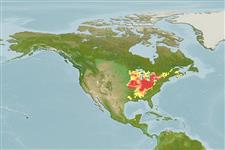Classification / Names
Common names | Synonyms | Catalog of Fishes (gen., sp.) | ITIS | CoL | WoRMS | Cloffa
Actinopterygii (ray-finned fishes) >
Perciformes (Perch-likes) >
Percidae (Perches) > Etheostomatinae
Etymology: Etheostoma: Greek, etheo = to strain + Greek, stoma = mouth; Rafinesque said "various mouths", but Jordan and Evermann suggest the name might have been intended as "Heterostoma (Ref. 45335); caeruleum: caeruleum meaning blue (Ref. 10294).
Environment / Climate / Range
Ecology
Freshwater; benthopelagic. Temperate; 4°C - 18°C (Ref. 2059), preferred ?; 46°N - 30°N
North America: Great Lakes and Mississippi River basins from southern Ontario in Canada and from western New York to Minnesota, and south to northern Alabama and Arkansas in the USA. Isolated populations in southwestern Mississippi and eastern Louisiana, and in upper Potomac River drainage in West Virginia, USA.
Size / Weight / Age
Maturity: Lm ? range ? - ? cm
Max length : 7.7 cm TL male/unsexed; (Ref. 5723); common length : 5.3 cm TL male/unsexed; (Ref. 12193); max. reported age: 3 years (Ref. 12193)
Adults inhabit fast gravel and rubble riffles of creeks and small to medium rivers (Ref. 5723, 10294); also found in streams (Ref. 10294). Feed on midge larvae, hydropsychid and hydroptilid caddisfly larvae, mayfly nymphs, and fish eggs (Ref. 10294). Distinct pairing during breeding (Ref. 36980). Eggs are found buried in the substrate (Ref. 7043).
Distinct pairing during breeding (Ref. 36980). Eggs are found buried in the substrate (Ref. 7043).
Page, L.M. and B.M. Burr, 1991. A field guide to freshwater fishes of North America north of Mexico. Houghton Mifflin Company, Boston. 432 p. (Ref. 5723)
IUCN Red List Status (Ref. 115185)
CITES (Ref. 94142)
Not Evaluated
Threat to humans
Harmless
Human uses
Tools
Special reports
Download XML
Internet sources
